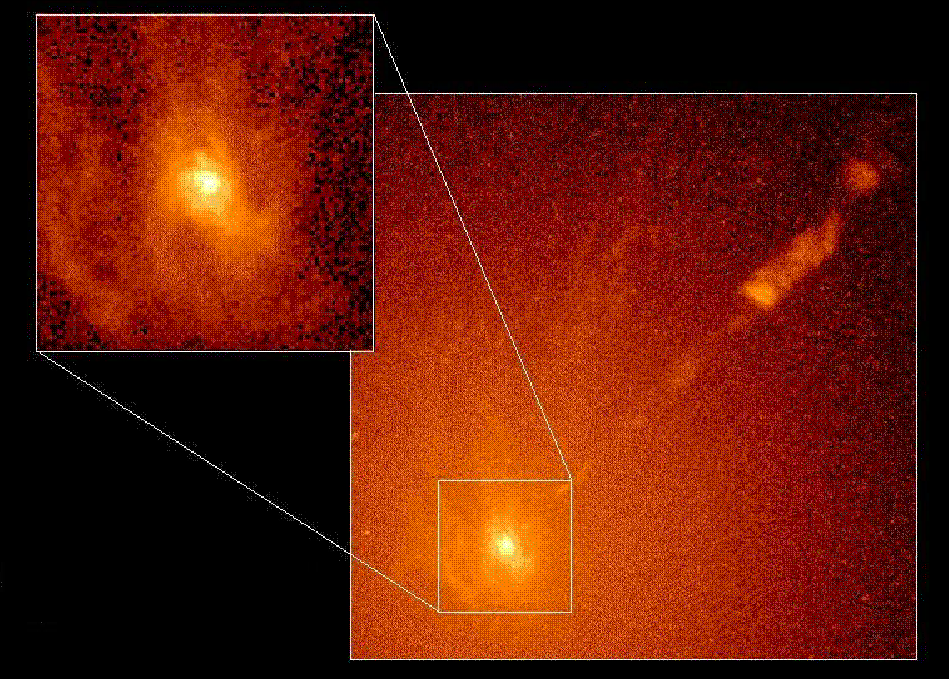
| Monsters in Galactic Nuclei |
|---|
Thirty million light years away, a monster rules the heart of a galaxy. With the gravity of a billion suns, it controls the movements of millions of stars in its domain. Long ago, it blazed with a light that eclipsed the galaxy it lives in. Today, it is dark and quiet. Looking at NGC 3115 in a telescope, we would not guess that it is present.
Such monsters lurk in the centers of many galaxies, including our own. They are almost surely black holes, an extremely dense form of matter predicted by the general theory of relativity. Soon after quasars were discovered in 1963, astronomers proposed that their tremendous luminosities come from matter falling into giant black holes. The confirmation of this idea has been one of the exciting sagas of modern astrophysics.
Radio astronomy is a technical byproduct of World War II. After the war, it progressed rapidly, as more and more sources of radio noise in the sky were identified with visible objects. Normal stars and galaxies proved to be weak sources, but some objects in the sky put out strong radio emission. Among these were gaseous nebulae, supernova remnants, and ``radio galaxies". Other sources did not correspond to any optical object or were close on the sky to an apparently ordinary star. Maarten Schmidt at Caltech was one of the astronomers who were trying to understand these strange radio stars. He observed them with a spectrograph on the 200 inch (5 m) telescope on Mount Palomar, and he quickly found that these quasi-stellar radio sources or ``quasars" were distinctly unlike stars. Their spectra showed only a few broad emission lines at unfamiliar wavelengths. In the midst of his puzzlement, he tried to plot the line spacings for the brightest of the objects, 3C 273, against the wavelengths of light emitted by hydrogen gas. Much to his surprise, the wavelengths matched, provided that the lines were redshifted by an unprecedented 16 %. This came as a huge shock. The Hubble law that describes the expansion of the universe immediately implied that 3C 273 is very far away. But it is not faint; it is a 13th magnitude ``star". It can be seen with a moderately large amateur telescope. Maarten Schmidt had just discovered one of the most distant objects known, and it had overexposed his first plates. So 3C 273 must be enormously luminous -- trillions of times more luminous than our sun. Another radio quasar, 3C 48, was confirmed within a few hours. Others followed. It was soon found that some quasars vary in brightness in only a few days or weeks. This shows that they are no larger than the solar system. How could such a huge luminosity come from such a small volume? Proposals included swarms of supernovae, supermassive stars, giant pulsars, and supermassive black holes. After a brief Darwinian struggle between theories, black holes emerged as the winners.
Less powerful versions of quasars are seen in some nearby galaxies. They are called ``Seyfert galaxies". Radio galaxies, Seyfert galaxies, and quasars are collectively known as active galactic nuclei or AGNs. All are thought to be powered by black holes accreting nearby gas and stars.
The escape velocity from the surface of an object depends on the mass of the object divided by its radius. If Nature can make the radius small enough, then the escape velocity reaches the speed of light. At this point, no matter or radiation can escape from the surface of the object to the universe outside. Furthermore, no atomic or subatomic forces can hold the object up against its own gravity -- the mass is doomed to collapse to an infinitesimal point. The original matter is lost from view forever. Only its gravity remains. The point of no return, where the radius gets small enough so that the escape velocity equals the speed of light, is called the Schwarzschild radius or the ``horizon". This radius is proportional to the mass of the hole. If the mass is 50 million solar masses, then the radius is equal to the radius of the Earth's orbit around the Sun. Because no light can escape, such an object is called a ``black hole". Any matter that later wanders inside the horizon is also lost from view, and its mass gets added to the mass of the hole. Theory and observations indicate that black holes of a few solar masses form when very massive stars die. Such black holes are seen in various places in our Galaxy; astronomers find them by their x-ray emission. As we shall see, the black holes in galactic nuclei are much bigger.
If no light can escape from black holes, then how can they explain the huge luminosities of quasars? The radiation comes from matter that is close to the hole but still outside the horizon. Matter that is falling into a black hole accelerates closer and closer to the speed of light as it approaches the horizon. A tremendous amount of energy is associated with this motion. Under some circumstances, this energy can be converted to radiation. For example, the gas is expected to form a disk around the black hole, and friction of the gas in this ``accretion disk" heats it up to very high temperatures. This is why it radiates so ferociously. In fact, it can liberate energy with an efficiency of ten percent of the theoretical limit, energy = mass times speed of light squared. In contrast, nuclear fusion reactions like those that power stars have an efficiency of less than 0.7 percent. For quasar luminosities, which range from a hundred billion to 100,000 billion solar luminosities, a black hole would have to eat 0.02 to 20 solar masses per year.
How massive does the hole need to be? If the above fueling rate lasts for the estimated lifetime of a quasar, which is about 10 million years, then it will build up the mass of the black hole to at least 100,000 to 100,000,000 solar masses. An independent estimate is based on the ``Eddington limit", which says that the black hole must be massive enough to pull in new fuel despite the fact that its radiation is trying to blow the fuel away. This minimum mass is a million to a billion solar masses, depending on the quasar's luminosity.
The strong gravity of a spinning black hole could explain the ability of some quasars to eject jets of material at speeds close to the speed of light. X-ray observations show that gas orbits the centers of some AGNs at speeds up to one-third the speed of light. This, too, supports the presence of a black hole. The location of the gas producing the broad optical and ultraviolet emission lines can be estimated for some AGNs by observing how the lines change with time. If the observed widths of the lines result from the Doppler effect caused by the orbital motion of the emitting gas clouds, then one can calculate the mass of the central object from the laws of gravity. The resulting masses are consistent with the arguments described above. From the black hole mass and the accretion rates, one expects the surface temperature of the accretion disk to resemble that of a very hot star. Consequently, the disk is expected to emit much of its radiation at ultraviolet wavelengths. Observations of quasars generally agree with this prediction. The accretion disk should be brightest at about ten Schwarzschild radii. This is consistent with the time scale of quasar variability.
A giant black hole in a galactic nucleus exerts a powerful gravitational force on nearby gas and stars, causing them to move at high speeds. This is hard to see in quasars, because they are far away and because the dazzling light of the active nucleus swamps the light from the host galaxy. In a radio galaxy with a fainter nucleus, the stars and gas are more visible. The giant elliptical galaxy Messier 87, one of the two brightest objects in the Virgo cluster of galaxies, is a radio galaxy with a bright jet emerging from its nucleus. It has long been thought to contain a black hole. Recent observations of Messier 87 with the Hubble Space Telescope (HST) reveal a disk of gas 500 light years in diameter (Figure 1) whose orbital speeds imply a central mass of 3 billion solar masses. The ratio of this mass to the central light output is more than 100 times the solar value. No normal population of stars has such a high mass-to-light ratio. This is consistent with the presence of a black hole, but it does not rule out some other concentration of underluminous matter.

Figure 1.~-- HST image of the gas disk near the center of Messier 87. The data were taken with the Second Wide Field/Planetary Camera (WFPC2) through a filter that isolates the red optical emission lines of hydrogen and nitrogen gas. The jet extends toward the upper-right. The inset is an expanded view of the gas disk; the region shown is 5 x 5 arcsec or 1300 x 1300 ly. [Image courtesy of NASA/Space Telescope Science Institute, based on data originally published by Ford, H. C., et al. 1994, ApJ, 435, L27.]
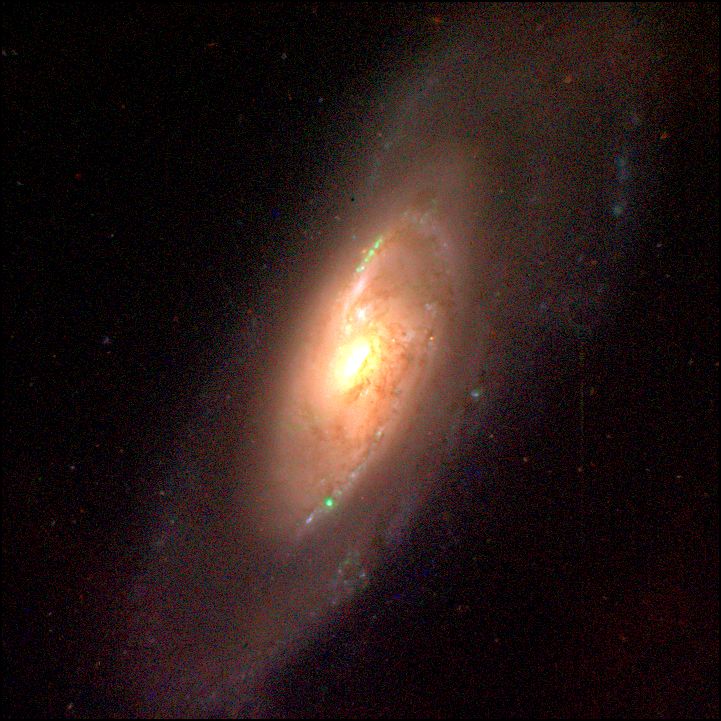
Figure 2.~-- CCD image of NGC 4258 obtained by Frei, Gunn & Tyson (1996, AJ, 111, 174) at the Palomar Observatory 60 inch (1.5 m) telescope using green, red, and near-infrared filters. An unusual aspect of this image is that foreground stars have been removed.
A more compelling argument is possible in the Seyfert galaxy NGC 4258, where orbiting gas in the nucleus emits microwave maser emission from water molecules. The location and velocity of this gas can be mapped with amazing precision by making coordinated observations with radio telescopes separated by large distances. The angular resolution given by this technique is 100 times better than that of HST. The measurements imply that 40 million solar masses lie within half a light year of the center. Could this material be a cluster of dark stars? Dan Maoz (now at Tel-Aviv University) has shown that the answer is ``no.'' There are two possibilities, failed stars or dead stars. Failed stars are ones that are too low in mass; their insides never get hot enough to ignite the nuclear reactions that power stars. They are called brown dwarfs. But brown dwarfs are light -- less than 0.08 solar masses -- so there would have to be many of them to explain the dark mass in NGC 4258. Then they would have to be very close together. As a result, most of them would collide with other brown dwarfs. Stars that collide generally stick together. But if two brown dwarfs of almost 0.08 solar masses merge, they become a luminous star, and then the dark cluster would light up. The other alternative is dead stars, that is, white dwarf stars, neutron stars, or stellar-mass black holes. But these are more massive than brown dwarfs, so there would be fewer of them. The gravitational evolution of clusters of stars is well understood: individual stars get ejected from the cluster, the remaining cluster contracts, and the evolution speeds up. Calculations show that a cluster of dead stars in NGC 4258 would evaporate completely in about 100 million years. From a cosmic perspective, this is almost no time at all. It is much less than the age of the galaxy. So the most astrophysically plausible alternatives to a black hole can be excluded. It is difficult to escape the conclusion that NGC 4258 contains a supermassive black hole.
Many quasars have redshifts of 2 or 3. This corresponds to a time when the universe was about 5 billion years old, only a third of its present age. At that time, many large galaxies had luminous active nuclei. Since then, quasars have mostly died out. Very few are active today. What is left is the waste mass from the quasar era -- black holes with masses of a million to a few billion solar masses that are starving for fuel. Some of them accrete slowly; this produces very little light. Many are not active at all. Since quasars were once found in most large galaxies, we expect that dormant supermassive black holes should hide in most large galaxies today.
How can we find these black holes? If they are dormant, they make their presence felt only through their gravitational pull on nearby stars and gas. When they are surrounded by a disk of stars or gas, this disk spins very rapidly. In fact, the signature of a black hole is that the disk spins too rapidly for the number of stars that it contains. Without an extra dark object in its middle, the disk would fly apart. More generally, the orbits of stars in a galactic nucleus are not all aligned in a disk but instead have random orientations. They swarm around like a cluster of bees, rather than spinning like a flying frisbee. A spectrograph sees light from many thousands of stars at once. Some are approaching us in their orbits and others are receding. As a result, the stellar absorption lines are broadened by the Doppler shift. Measuring the width of the lines tells us the random velocities of the stars. From the rotation velocities or the random velocities, the laws of gravity tell us the mass.
Why is the black hole search difficult? After all, quasars have been known for well over 30 years. For all of this time, there has been an acute need to confirm or disprove the theory that they are powered by black holes. The answer is that even a supermassive black hole dominates the motions of stars and gas in only a tiny volume near the center. At most ground-based observatories, this volume is hopelessly blurred by atmospheric turbulence or ``seeing''. Only with the best ground-based spatial resolution does it become possible to find black holes in favorable cases, and only with the resolution of the refurbished HST does it become routine to find black holes in most nearby galaxies.
More specifically: black holes of a billion solar masses live in galaxies whose total masses are more than a hundred billion suns. Over most of the galaxy, the stars move in response to the gravity of the other stars. They do not know that a black hole is present at the center. Only near the nucleus is the combined mass in stars smaller than the mass of the black hole. Only here does it dominate the local gravity. Even for our nearest neighbors like the Andromeda Galaxy (which is about 2 million light years away), the region of influence of the black hole has an angular size of only about 1 arc second. Ground-based telescopes that have especially good resolution can find black holes in such objects. For example, the telescopes at the 13,800-foot summit of Mauna Kea in Hawaii have exceptionally good spatial resolution, because 40\% of the Earth's atmosphere is below them. Searches by one of us (Kormendy) found five black holes in the late 1980s and early 1990s using the Canada-France-Hawaii Telescope on Mauna Kea.
The first of these was in the Andromeda Galaxy. Its 30,000,000 solar mass black hole was discovered independently and almost simultaneously by Alan Dressler (Carnegie Observatories) and Douglas Richstone (University of Michigan) using the 200 inch telescope at Palomar. Messier 32, the small elliptical companion of the Andromeda galaxy, also has a black hole. This one ``weighs'' a mere 3 million solar masses.
NGC 3115 is a nearby S0 galaxy, an intermediate type between spirals and ellipticals in Edwin Hubble's classification scheme. Spectroscopic observations made in 1992 with the Canada-France-Hawaii telescope revealed rapid rotation from an edge-on disk and large random velocities in the surrounding bulge stars. These implied a black hole of mass one billion suns. In 1996, observations with HST confirmed this result and showed a velocity dispersion as high as 600 km/s in the nucleus. This was the highest measured in any galactic center. NGC 3115 contains a tiny nuclear star cluster (Figure 3), exactly the sort of density cusp that astronomers have long expected to find around black holes. This nucleus would fly apart in a few tens of thousands of years unless there is a dark mass equivalent to a billion suns holding it together.

Figure 3.~-- (left) HST WFPC2 color image of NGC 3115 showing the central disk of stars and the nuclear star cluster. The right panel shows a model of the nuclear disk. The center panel shows the difference; it emphasizes the tiny nuclear star cluster. Brightness is proportional to the square root of intensity. All panels are 11.6 arcsec square. [This figure is taken from Kormendy et al. 1996, ApJ, 459, L57.]
Is there a black hole in our own galaxy, the Milky Way? The center of our Galaxy is only 28,000 light years away, but its visible light is completely absorbed by intervening dust. Fortunately, infrared light penetrates the dust. Early infrared measurements suggested that we have a black hole of about a million solar masses. It is coincident with a weak radio source called Sgr A* that is exceptionally tiny -- radio observations show that it is about the size of Saturn's orbit around the Sun. In a dramatic breakthrough, two groups of astronomers led by Reinhard Genzel in Munich, Germany, and Andrea Ghez at UCLA, have measured the motions of individual stars near the Galactic center as projected on the plane of the sky (Figure 4). They used a technique called ``speckle imaging" to reduce the blurring effect of the Earth's atmosphere. The velocity dispersion increases to 400 km/s at a distance of 0.03 light years from Sgr A*. Here stars have such small orbits that they revolve around the Galactic center in a few decades. We can look forward to seeing the Galactic center rotate once in our lifetimes! The rapid motions show that there is a mass of 3 million solar masses centered on Sgr A* (Fig. 5). Notice how the mass enclosed inside a particular distance from Sgr A* stops dropping toward the center at a distance of about 1 pc (3.26 ly). This means that the mass in stars inside 3 ly (see the long green dashes) has become negligible compared to the dark mass at the center. As in NGC 4258, the implied density of matter is too high to allow a cluster of dark stars or stellar remnants. Because of this work, the most compelling example of a supermassive black hole is in our own Galaxy.
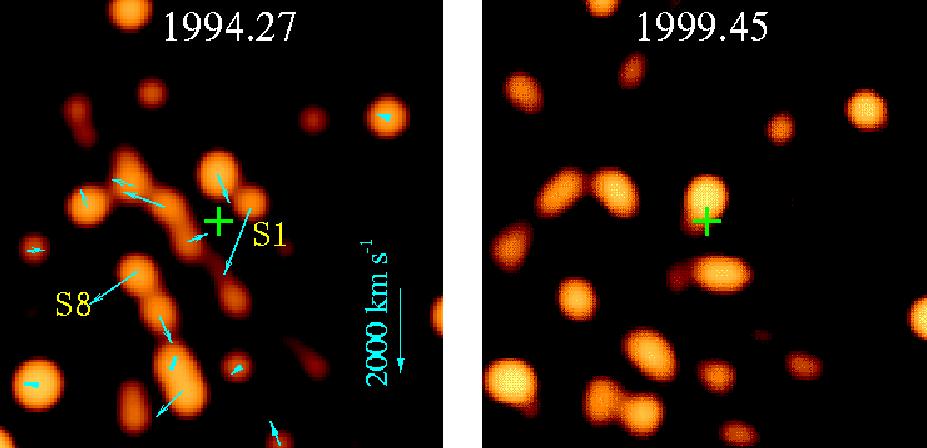
Figure 4.~-- Images of the star cluster surrounding Sgr A* (green cross) at the times indicated. The arrows in the left frame show approximately where the stars have moved in the right frame. Star S1 has a total motion in the plane of the sky (``proper motion'') of about 1600$ km/s. [This figure is updated from Eckart & Genzel 1997, MNRAS, 284, 576 and was kindly provided by Andreas Eckart.]
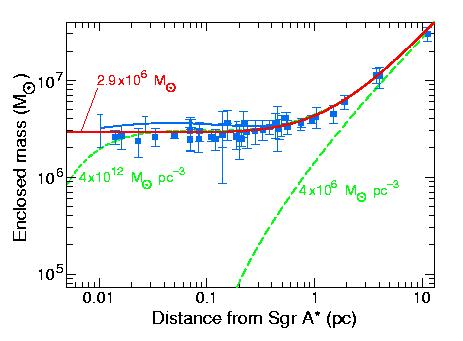
Figure 5.~-- Central mass distribution in our Galaxy implied by the observed velocities (blue points and curve). Long green dashes show the mass in stars. The red curve represents the stars plus a point mass of 2.9 million Suns. The short green dashes represent the largest and lowest-density dark cluster that is allowed by the observations. It has a central density of 4000 billion solar masses per cubic parsec and is excluded on astrophysical grounds. [This figure is updapted from Genzel et al. 1997, MNRAS, 291, 219 and was kindly provided by Reinhard Genzel.]
As of June 2000, we have good evidence for supermassive black holes in 33 galaxies (Table 1). This is enough for a quantum improvement in what we can learn about black holes and galaxy formation.
First, the amount of mass that we find in black holes is consistent with predictions of the waste mass left behind by quasars. Also, the individual masses of the black holes in Table 1 are consistent with predictions from quasar energies.
Two new results are fundamental correlations between black hole masses and the properties of their host galaxies. Galaxies come in two basic types, flat spinning disks (like frisbees) and more nearly spherical bulges that rotate a little but that mostly are supported by random motions of stars. Many galaxies, like our own and the Andromeda galaxy, consist of a bulge in the middle of a disk. When a galaxy contains only a bulge and not a disk, it is called an elliptical galaxy. In the following discussion, use of the term ``bulge'' includes elliptical galaxies. Supermassive black holes have now been found in elliptical galaxies and in galaxies that contain both a bulge and a disk but not in galaxies that consist only of a disk. In 1993, one of us (Kormendy) found that black hole mass is roughly proportional to the luminosity of the bulge component of the host galaxy. This is confirmed by the new black hole detections (Figure 6). It implies that the mass of a black hole is always about 0.2 % of the mass of the bulge. The cause of this correlation is not known, but it implies that, as galaxies form, an approximately standard fraction of the mass ends up in the black hole. The correlation contains important clues to the origin and growth of galaxies.
In the past few months, a new and more fundamental correlation has been found by Karl Gebhardt (now at the University of Texas at Austin) and collaborators, including Kormendy. More massive black holes live in galaxies whose stars move faster (Figure 6, right). Of course, the stars near the center must have high velocities; they are the ones that are used to find the black holes. Concluding that black holes correlate with these stars would be circular reasoning. Instead, the new correlation involves the stars in the main bodies of the galaxies. These stars do not feel the black holes. But they, too, move more rapidly than do stars in galaxies with less massive black holes. The scatter in the new correlation is almost zero. That is, it is almost the same as the measurement errors. Tight correlations in astronomy have always led to fundamental advances in our understanding of how things work. They tell us that there is an underlying astrophysical constraint that we didn't know about before. In the present case, we do not yet have an explanation of why the correlation is so tight. But it implies that there is something almost magically regular about the process by which black holes are fed and grown.
On the other hand, we can use the correlation without knowing why it exists. The smallness of the scatter and the existence of two correlations have much to say about when, in relation to their host galaxies, black holes grew.
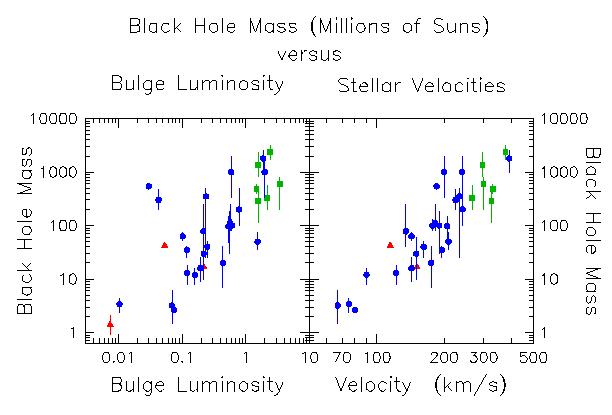
Figure 6.~-- The left plot shows the correlation between black hole mass and the luminosity of the bulge component of the host galaxy in units of the total luminosity of the Milky Way. It tells us that more luminous bulges -- which are also more massive bulges -- contain more massive black holes. Each black hole is represented by one point. Blue points are detections based on the motions of stars. Green points are based on the rotation speeds of hot gas disks. Red points are based on the rotation speeds of cold maser gas disks. The right-hand plot shows the new correlation between black hole mass and the average random speeds of stars in the host galaxies. It says that bigger black holes live in galaxies whose stars move faster. The points have the same meaning as in the left plot.
So far, astronomers have found a supermassive black hole in every galaxy observed that contains a bulge component. Therefore the observed correlations say that black hole mass is intimately connected with bulge formation. Alternative theories come in two extremes. (1) Maybe black holes came first in a standard size, namely 0.2 % of the mass of the first galaxy fragments. Then mergers of small galaxies made big galaxies, and the big galaxies still contained 0.2 % mass black holes because, when two galaxies merge, their black holes merge, too. Or (2) Maybe black holes started out small and then grew during galaxy formation. If 0.2 % of the gas that makes stars always gets fed to the central black hole, then the black hole mass fraction is always 0.2 %.
Both theories include an explanation of quasars, but they differ in how they use quasars. In theory (1), the black holes come first and then regulate galaxy formation, while in theory (2) the black holes and galaxies grow together.
Which theory is correct? Two arguments favor (2).
Observations show that there are two kinds of bulge-like components and that both contain black holes. One kind, called a pseudobulge, is believed to form in a bulgeless pure disk galaxy when gas flows inward toward the center. We observe that disks do not contain supermassive black holes in nearly the same proportion (0.2 % of the mass) as do bulges. But seven galaxies in Table 1 contain pseudobulges and all of them contain standard black holes with about 0.2 % of the pseudobulge mass. So the black holes must have grown during the process that made the pseudobulges.
The second argument comes from a comparison of the two correlations of black hole mass with host galaxy properties. One correlation says that bigger bulges contain bigger black holes, with exceptions: a few galaxies contain anomalously big black holes. But the stars in these galaxies move faster, too, and they do so by precisely the right amount so that the scatter in the black hole mass -- random velocity correlation is small. What does this mean? The reason why the stars move so rapidly is that the galaxy collapsed to an unusually small size when it formed. Then stars are closer together, so their gravitational forces on each other are bigger, so they must move faster. But if black holes are unusually massive whenever galaxies are unusually collapsed, then black hole masses was probably fixed by the collapse process. The alternative -- that bigger black holes cause a galaxy to be more collapsed -- is less likely, because bigger black holes would power brighter quasars; their radiation would push on the protogalactic gas and would tend to make it collapse less, not more.
Based on these arguments, we conclude that the major events that made the bulge and the major periods of black hole growth were the same events. Galaxy formation directly results in the black hole feeding that makes quasars shine.
The idea that bulge formation, black hole growth, and quasars happen together is not new, but it has been only one of several competing theories. In 1988, David Sanders (now at the University of Hawaii) and a group of colleagues suggested that a rare type of galaxy that is extremely luminous in infrared light is an early stage in the development of quasars. These ``ultraluminous infrared galaxies'' were quickly shown to be galaxy mergers that are making bulges. They are our best local examples of how bulges formed. But are they making quasars? The idea was attractive but controversial. It led to a decade-long debate about whether ultraluminous infrared galaxies are powered by active nuclei or by starbursts. Recent observations suggest that both sides are correct: about 2/3 of the energy comes from starbursts and about 1/3 comes from nuclear activity. This is just what the present picture requires. HST observations of quasar host galaxies also add support, because many are disturbed systems and plausible mergers in progress. Recent submillimeter detections of distant galaxies that are similar to ultraluminous infrared galaxies have been interpreted by some astronomers as the discovery of bulges in formation. Our black hole results add strong support to all of these conclusions. The developing interconnection between black holes and other work on galaxy formation is one reason why the combined picture is compelling.
Looking back on the past 15 years, we are struck by how fundamentally astronomers have changed their views of black holes. In the mid-1980s, AGN research was thriving; the engines that power this activity were believed to be black holes, although an observational test -- the dynamical detection of black holes -- was a high priority. However, all of this work was very disconnected from other research on galactic structure and formation. Now we believe that supermassive black holes are standard equipment in galaxies with bulges. Black holes affect galactic structure in a variety of ways, and they play an important role in galaxy formation. They are no longer uncertain oddities that are postulated only to explain some spectacular but specialized observations. Instead, black holes have become a necessary ingredient in our understanding of galaxies. We live in exciting times. Continuing HST searches are finding more and more black holes. By studying them, our understanding of galaxy formation and evolution should improve rapidly in the coming years.
University of Texas Astronomy Home Page
John Kormendy (kormendy@astro.as.utexas.edu)